
95% of researchers rate our articles as excellent or good
Learn more about the work of our research integrity team to safeguard the quality of each article we publish.
Find out more
CORRECTION article
Front. Earth Sci. , 04 November 2022
Sec. Solid Earth Geophysics
Volume 10 - 2022 | https://doi.org/10.3389/feart.2022.1073465
This article is part of the Research Topic Advanced Methods for Interpreting Geological and Geophysical Data View all 36 articles
This article is a correction to:
Estimation of porosity and facies distribution through seismic inversion in an unconventional tight sandstone reservoir of Hangjinqi area, Ordos basin
 Umar Ashraf1†
Umar Ashraf1† Aqsa Anees1†
Aqsa Anees1† Wanzhong Shi2,3*
Wanzhong Shi2,3* Ren Wang2,3
Ren Wang2,3 Muhammad Ali4
Muhammad Ali4 Ren Jiang5
Ren Jiang5 Hung Vo Thanh6
Hung Vo Thanh6 Ibrar Iqbal7
Ibrar Iqbal7 Xiaonan Zhang1
Xiaonan Zhang1 Hucai Zhang1*
Hucai Zhang1*A Corrigendum on
Estimation of porosity and facies distribution through seismic inversion in an unconventional tight sandstone reservoir of Hangjinqi area, Ordos basin
by Ashraf U, Anees A, Shi W, Wang R, Ali M, Jiang R, Vo Thanh H, Iqbal I, Zhang X and Zhang H (2022) Front. Earth Sci. 10:1014052. doi: 10.3389/feart.2022.1014052
In the published article, Figures 2, 4–7 show some resemblance to a recently published article (Anees et al., 2022) as the same data and software were used as part of the authors’ research. Modifications have been made to the figures, which aim to establish that the current study has no resemblance to any of the previously published articles. The colors and layout of Figures 2, 4–7 have been revised by employing the same well, logs, and section locations and zoomed versions of the original figures have been provided. The current study is original and focuses on the porosity and facies estimation of the Hangjinqi area. The corrected Figures 2, 4–7 and their captions appear below.
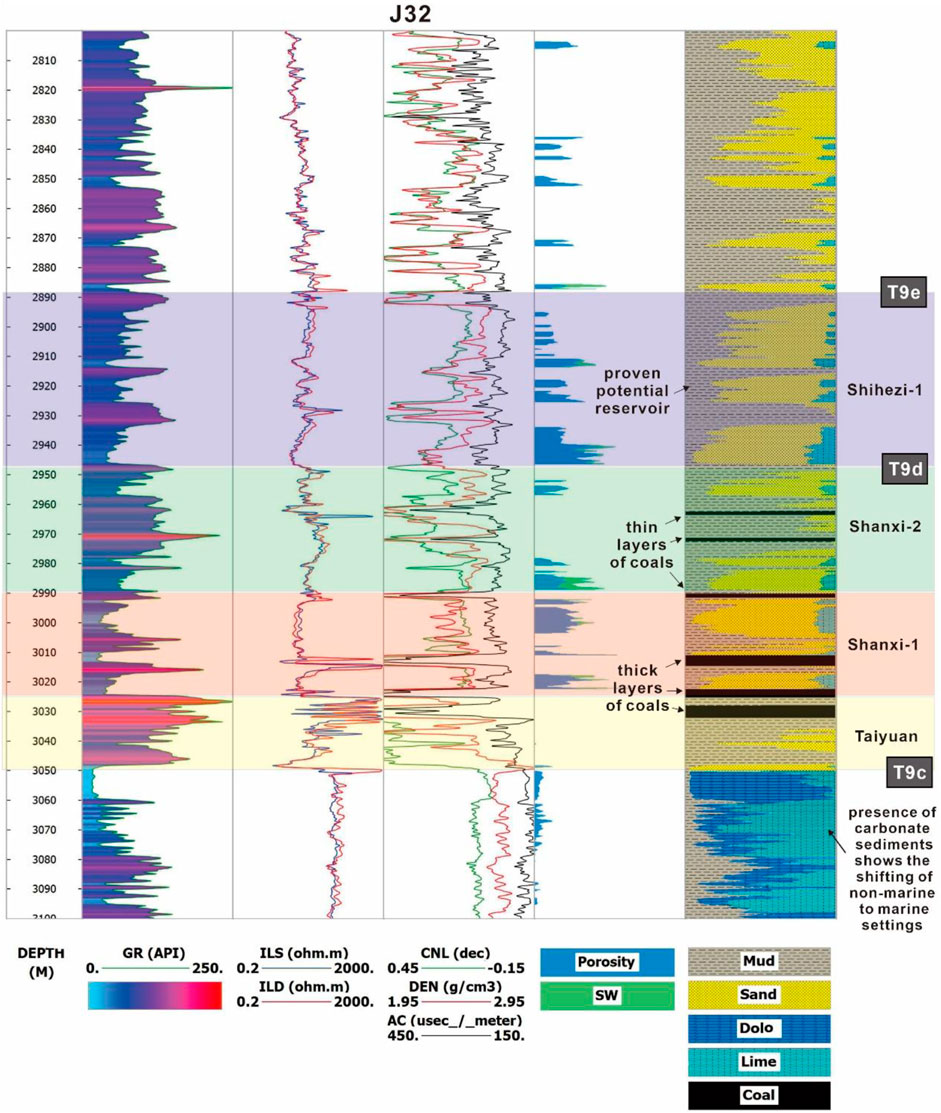
FIGURE 2. Petrophysical analysis of J32. The highlighted zones show the targeted zone of interest (ZOI). Shihezi-1 formation is a proven reservoir and mostly consists of sand and mud facies. Whereas, Shanxi-2 and Shanxi-shows coal layers, but also shows prominent porous zones. The Taiyuan formation zone shows a thick coal layer and prominent mud facies. The area below the ZOI shows frequent carbonate facies highlighting the marine depositional environment.
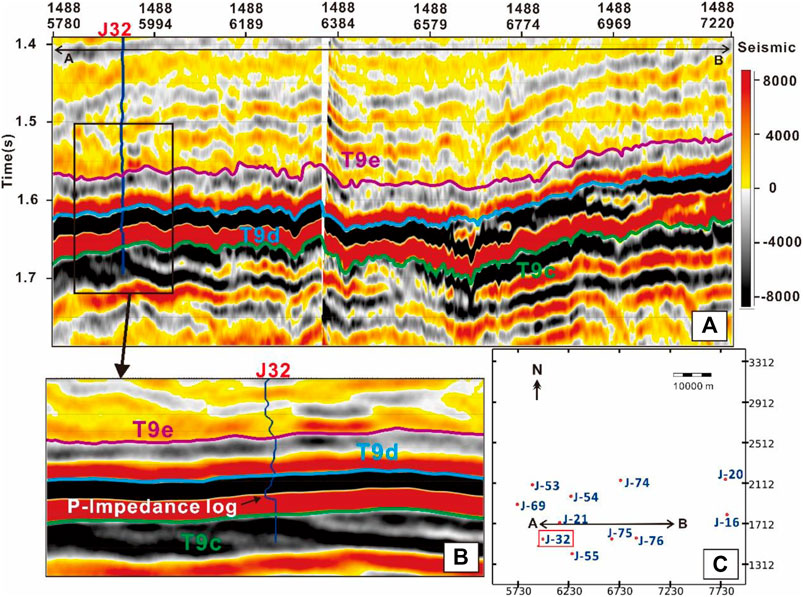
FIGURE 4. (A) A inline showing a regional section crossing well J32. Three horizons are marked named T9c, T9d, and T9e. (B) A zoomed section highlights the deflections of P-impedance log within the ZOI. (C) Basemap showing the corresponding studied inline (AB) and well J32.
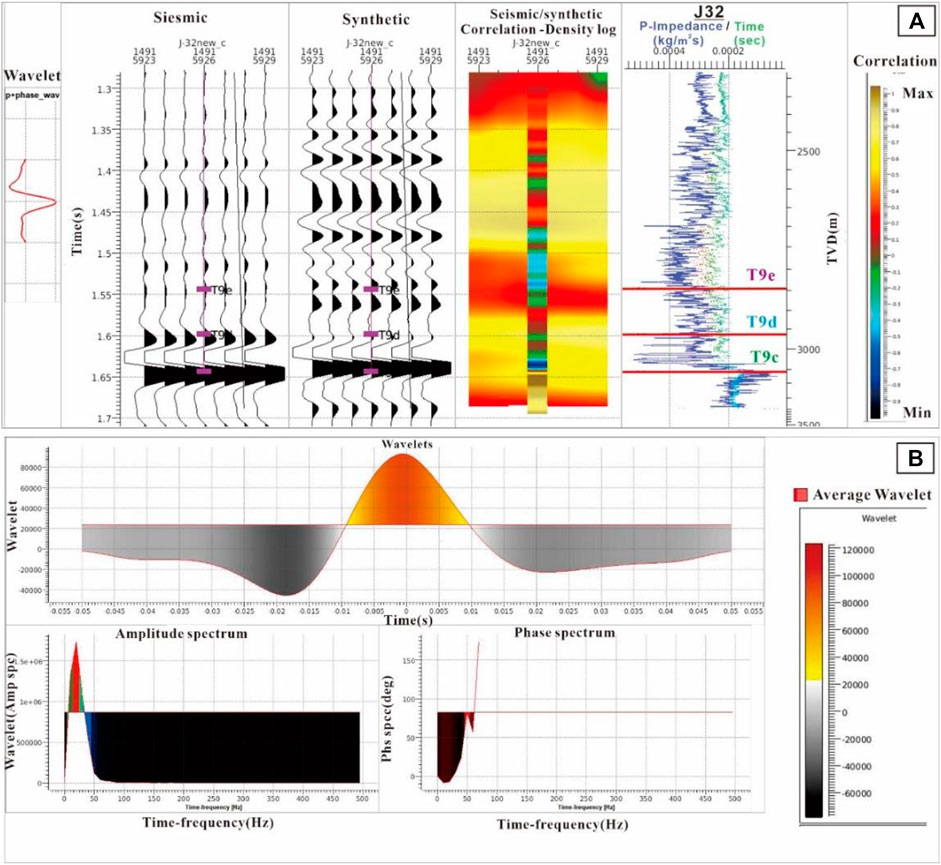
FIGURE 5. (A) The well editing window shows the synthetic seismogram utilizing the well J32. The first panel shows seismic data from well traces. The second and third panels show synthetics, third shows the correlation between the seismic and synthetics. The highest value shows a good correlation, whereas the lowest value shows a minimum correlation. An overlay log on the correlation panel shows the variations of the RHOB log within ZOI. The last and fourth panel shows the time and P-impedance log of well J32. (B) An average wavelet along with amplitude and phase spectrums were made by utilizing the wavelets of all the studied wells.
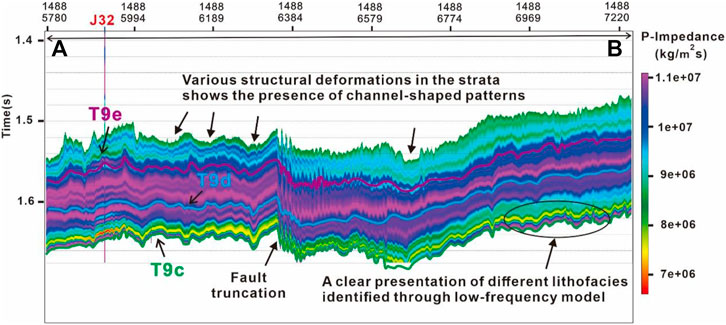
FIGURE 6. Low-frequency model of the ZOI that shows the presence of fault truncations and channel-shaped patterns associated with structural variations. A highlighted zone evidently highlights the presence of various lithofacies.
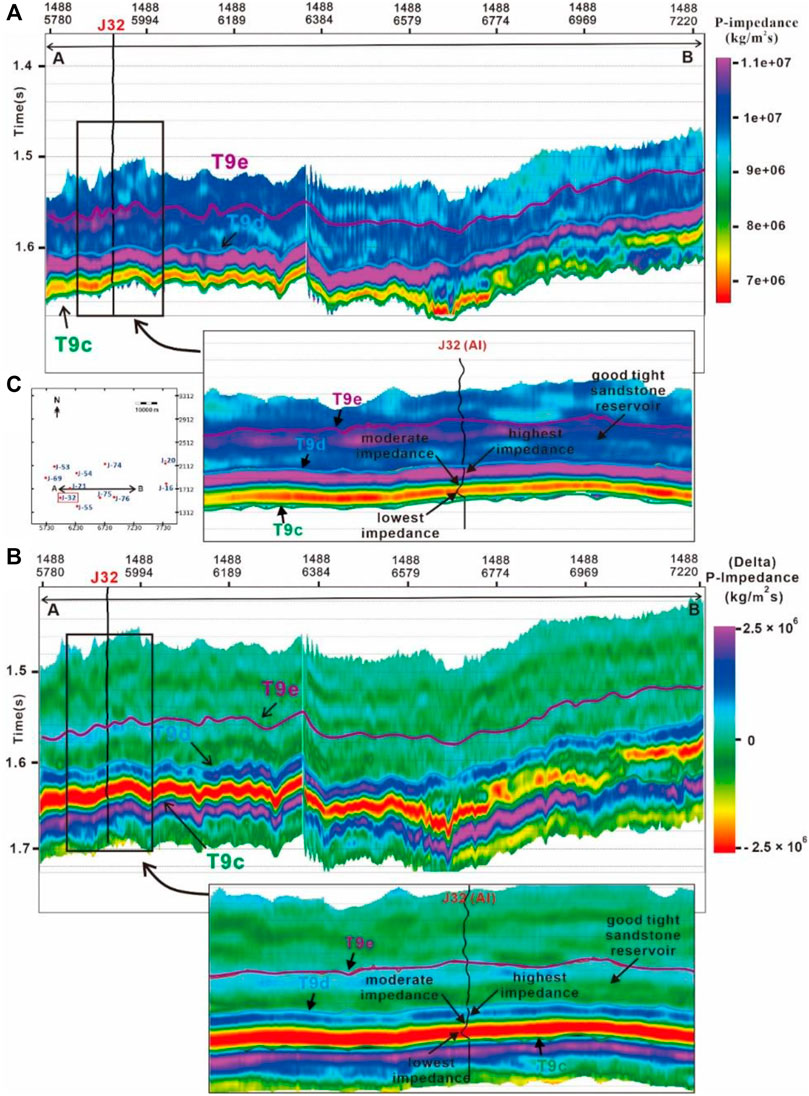
FIGURE 7. (A) Absolute AI broadband model along with the zoomed section on J32 location (B). Bandlimited AI model along with a zoom section. An overlay well J32 on inverted AI models highlights the differences in impedance values. (C) A basemap showing the location of J32 and studied inline for inverted sections.
The authors apologize for this error and state that this does not change the scientific conclusions of the article in any way. The original article has been updated.
All claims expressed in this article are solely those of the authors and do not necessarily represent those of their affiliated organizations, or those of the publisher, the editors and the reviewers. Any product that may be evaluated in this article, or claim that may be made by its manufacturer, is not guaranteed or endorsed by the publisher.
Anees, A., Zhang, H., Ashraf, U., Wang, R., Thanh, H. V., Radwan, A. E., et al. (2022). Sand-ratio distribution in an unconventional tight sandstone reservoir of Hangjinqi area, Ordos Basin: Acoustic impedance inversion-based reservoir quality prediction. Front. Earth Sci. 10, 1018105. doi:10.3389/feart.2022.1018105
Keywords: constrained sparse spike inversion, porosity estimation, Shanxi and Taiyuan formations, tight sandstone, Hangjinqi area, Ordos basin
Citation: Ashraf U, Anees A, Shi W, Wang R, Ali M, Jiang R, Thanh HV, Iqbal I, Zhang X and Zhang H (2022) Corrigendum: Estimation of porosity and facies distribution through seismic inversion in an unconventional tight sandstone reservoir of Hangjinqi area, Ordos basin. Front. Earth Sci. 10:1073465. doi: 10.3389/feart.2022.1073465
Received: 18 October 2022; Accepted: 19 October 2022;
Published: 04 November 2022.
Approved by:
Frontiers Editorial Office, Frontiers Media SA, SwitzerlandCopyright © 2022 Ashraf, Anees, Shi, Wang, Ali, Jiang, Thanh, Iqbal, Zhang and Zhang. This is an open-access article distributed under the terms of the Creative Commons Attribution License (CC BY). The use, distribution or reproduction in other forums is permitted, provided the original author(s) and the copyright owner(s) are credited and that the original publication in this journal is cited, in accordance with accepted academic practice. No use, distribution or reproduction is permitted which does not comply with these terms.
*Correspondence: Wanzhong Shi, c2hpd3pAY3VnLmVkdS5jbg==; Hucai Zhang, emhhbmdoY0B5bnUuZWR1LmNu
†These authors have contributed equally to this work and share first authorship
Disclaimer: All claims expressed in this article are solely those of the authors and do not necessarily represent those of their affiliated organizations, or those of the publisher, the editors and the reviewers. Any product that may be evaluated in this article or claim that may be made by its manufacturer is not guaranteed or endorsed by the publisher.
Research integrity at Frontiers

Learn more about the work of our research integrity team to safeguard the quality of each article we publish.